Robust Weighted Sum Harvested Energy Maximization for SWIPT Cognitive Radio Networks Based on Particle Swarm Optimization
Abstract
:1. Introduction
- For the perfect CSI, we formulate the non-convex optimization problem for the WSHE of all secondary receivers including constraints to limited transmission power at the ST, minimum required SINR at each SR, and interference threshold at each PU. The objective function is non-convex due to the coupled design variables of both the transmit beamforming vectors at the ST and the PS ratios at the SRs. Therefore, we solve it in two steps based on two variable groups of beamforming vectors and PS ratios. In the first step, we fix the PS ratios and obtain the optimal beamforming vectors by applying a semidefinite relaxation (SDR) technique. Interestingly, we can show that SDR is tight for our problem. In the second step, we propose an algorithm based on particle swarm optimization (PSO) to find the approximate optimal PS ratios. The baseline schemes are considered for performance comparison, in which the zero-forcing beamforming vectors at the ST and the equal power splitting ratios at the SRs are applied.
- For the imperfect CSI, the S-Procedure and SDR technique are applied to recast the robust WSHE maximization problem as a semidefinite programming (SDP) problem. Then, the similar PSO-based method is used to solve the formulated problem. However, we only obtain the upper bound value of WSHE since the optimal solutions are unlikely to satisfy the rank-1 constraints.
- Finally, simulation results show that the proposed PSO-SDR has fast convergence and better performance compared to the other baseline schemes. In addition, the the proposed PSO-SDR converges to the optimal value, achieved by the brute-force search (BFS) method, while obtaining significantly lower computational complexity.
2. System Description
3. Problem Formulation and Solution
3.1. SDR Approach with Fixed PS Ratios
3.2. PSO-SDR Approach to Maximizing WSHE
3.3. Zero-Forcing Beamforming (ZFBF) Problem
3.4. Equal Power Splitting (EPS) Problem
4. Robust WSHE Maximization with Imperfect Channels
5. Simulation Results
6. Conclusions
Acknowledgments
Author Contributions
Conflicts of Interest
References
- Bi, S.; Ho, C.K.; Zhang, R. Wireless powered communication: Opportunities and challenges. IEEE Commun. Mag. 2015, 53, 117–125. [Google Scholar] [CrossRef]
- Ding, Z.; Ng, D.W.K.; Peng, M.; Suraweera, H.A.; Schober, R.; Poor, H.V. Application of smart antenna technologies in simultaneous wireless information and power transfer. IEEE Commun. Mag. 2015, 53, 86–93. [Google Scholar] [CrossRef]
- Shi, Q.; Liu, L.; Xu, W.; Zhang, R. Joint transmit beamforming and receive power splitting for MISO SWIPT systems. IEEE Trans. Wirel. Commun. 2014, 13, 3269–3280. [Google Scholar] [CrossRef]
- Vu, Q.D.; Tran, L.N.; Farrel, R.; Hong, E.K. An Efficiency Maximization Design for SWIPT. IEEE Signal Process. Lett. 2015, 22, 2189–2193. [Google Scholar] [CrossRef]
- Zhang, R.; Ho, C.K. MIMO Broadcasting for Simultaneous Wireless Information and Power Transfer. IEEE Trans. Wirel. Commun. 2013, 12, 1989–2001. [Google Scholar] [CrossRef]
- Ding, Z.; Krikidis, I.; Sharif, B.; Poor, H.V. Wireless information and power transfer in cooperative networks with spatially random relays. IEEE Trans. Wirel. Commun. 2014, 13, 4440–4453. [Google Scholar] [CrossRef]
- Timotheou, S.; Krikidis, I.; Zheng, G.; Ottersten, B. Beamforming for MISO Interference Channels with QoS and RF Energy Transfer. IEEE Trans. Wirel. Commun. 2014, 13, 2646–2658. [Google Scholar]
- Feng, R.; Li, Q.; Zhang, Q.; Qin, J. Robust Secure Transmission in MISO Simultaneous Wireless Information and Power Transfer System. IEEE Trans. Veh. Technol. 2015, 64, 400–405. [Google Scholar] [CrossRef]
- Liao, J.; Khandaker, M.R.A.; Wong, K.K. Robust power-splitting SWIPT beamforming for broadcast channels. IEEE Commun. Lett. 2016, 20, 181–184. [Google Scholar] [CrossRef]
- Wang, F.; Peng, T.; Huang, Y.; Wang, X. Robust transceiver optimization for power-splitting based downlink MISO SWIPT systems. IEEE Signal Process. Lett. 2015, 22, 1492–1496. [Google Scholar] [CrossRef]
- Chu, Z.; Zhu, Z.; Xiang, W.; Hussein, J. Robust beamforming and power splitting design in MISO SWIPT downlink system. IET Commun. 2016, 10, 691–698. [Google Scholar] [CrossRef]
- Nasir, A.A.; Tuan, H.D.; Ngo, D.T.; Durrani, S.; Kim, D.I. Path-Following Algorithms for Beamforming and Signal Splitting in RF Energy Harvesting Networks. IEEE Commun. Lett. 2016, 20, 1687–1690. [Google Scholar] [CrossRef]
- Goldsmith, A.; Jafar, S.A.; Maric, I.; Srinivasa, S. Breaking spectrum gridlock with cognitive radios: An information theoretic perspective. Proc. IEEE 2009, 97, 894–914. [Google Scholar] [CrossRef]
- Mohjazi, L.; Dianati, M.; Karagiannidis, G.K.; Muhaidat, S. RF-powered cognitive radio networks: Technical challenges and limitations. IEEE Commun. Mag. 2015, 53, 94–100. [Google Scholar] [CrossRef]
- Zheng, G.; Ho, Z.; Jorswieck, E.A.; Ottersten, B. Information and Energy Cooperation in Cognitive Radio Networks. IEEE Trans. Wirel. Commun. 2014, 62, 2290–2303. [Google Scholar] [CrossRef]
- Ng, D.W.K.; Lo, E.S.; Schober, R. Multi-Objective Resource Allocation for Secure Communication in Cognitive Radio Networks with Wireless Information and Power Transfer. IEEE Trans. Veh. Technol. 2016, 65, 3166–3184. [Google Scholar] [CrossRef]
- Yang, Z.; Ding, Z.; Fan, P.; Karagiannidis, G.K. Outage performance of cognitive relay networks with wireless information and power transfer. IEEE Trans. Veh. Technol. 2016, 65, 3828–3833. [Google Scholar] [CrossRef]
- Lee, S.; Zhang, R. Cognitive wireless powered network: Spectrum sharing models and throughput maximization. IEEE Trans. Cogn. Commun. Netw. 2015, 1, 335–346. [Google Scholar] [CrossRef]
- Tuan, P.V.; Koo, I. Optimal Multiuser MISO Beamforming for Power-Splitting SWIPT Cognitive Radio Networks. IEEE Access 2017, 5, 14141–14153. [Google Scholar] [CrossRef]
- Luo, Z.Q.; Ma, W.K.; So, A.M.C.; Ye, Y.; Zhang, S. Semidefinite relaxation of quadratic optimization problems. IEEE Signal Process. Mag. 2010, 27, 20–34. [Google Scholar] [CrossRef]
- Grant, M.; Boyd, S. CVX: Matlab Software for Disciplined Convex Programming Version 2.1. Available online: http://cvxr.com/cvx (accessed on 22 February 2017).
- Kennedy, J.; Eberhart, R. Particle swarm optimization. In Proceedings of the IEEE International Conference on Neural Networks, Perth, Australia, 27 November–1 December 1995; pp. 1942–1948. [Google Scholar]
- Ghasemi, A.; Sousa, E.S. Fundamental limits of spectrum sharing in fading environment. IEEE Trans. Wirel. Commun. 2007, 6, 649–658. [Google Scholar] [CrossRef]
- Wu, Q.; Tao, M.; Ng, D.W.K.; Chen, W.; Schober, R. Energy-efficient resource allocation for wireless powered communication networks. IEEE Trans. Wirel. Commun. 2016, 15, 2312–2327. [Google Scholar] [CrossRef]
- Wu, Q.; Chen, W.; Ng, D.W.K.; Chen, W.; Schober, R. User-Centric Energy Efficiency Maximization for Wireless Powered Communication Networks. IEEE Trans. Wirel. Commun. 2016, 15, 6898–6912. [Google Scholar] [CrossRef]
- Boyd, S.; Vandenberghe, L. Convex Optimization; Cambridge University Press: Cambridge, UK, 2004. [Google Scholar]
- Bengtsson, M.; Ottersten, B. Optimal and suboptimal transmit beamforming. In Handbook of Antennas in Wireless Communications; CRC Press: Boca Raton, FL, USA, 2001; Chapter 18. [Google Scholar]
- Huang, Y.; Palomar, D.P. Rank-constrained separable semidefinite programming with applications to optimal beamforming. IEEE Trans. Signal Process. 2010, 58, 664–678. [Google Scholar] [CrossRef]
- Hjorungnes, A.; Gesbert, D. Complex-Valued Matrix Differentiation: Techniques and Key Results. IEEE Trans. Signal Process. 2007, 55, 2740–2746. [Google Scholar] [CrossRef]
- Zheng, G.; Wong, K.K.; Ottersten, B. Robust cognitive beamforming with bounded channel uncertainties. IEEE Trans. Signal Process. 2009, 57, 4871–4881. [Google Scholar] [CrossRef]
- Hjorungnes, A. Complex-Valued Matrix Derivatives with Applications; Cambridge University Press: Cambridge, UK, 2011. [Google Scholar]
- Brandwood, D.H. A complex gradient operator and its application in adaptive array theory. Proc. Inst. Elect. Eng. 1983, 130, 11–16. [Google Scholar]
- Chi, C.Y.; Li, W.C.; Lin, C.H. Convex Optimization for Signal Processing and Communications: From Fundamentals to Applications; CRC Press: Boca Raton, FL, USA, 2017. [Google Scholar]
- Robinson, J.; Samii, Y.R. Particle swarm optimization in electromagnetics. IEEE Trans. Antennas Propag. 2004, 52, 397–407. [Google Scholar] [CrossRef]
- Tuan, P.V.; Koo, I. Throughput maximisation by optimising detection thresholds in full-duplex cognitive radio networks. IET Commun. 2016, 10, 1355–1364. [Google Scholar] [CrossRef]
- Karipidis, E.; Sidiropoulos, N.D.; Luo, Z.Q. Quality of service and max-min-fair transmit beamforming to multiple co-channel multicast groups. IEEE Trans. Signal Process. 2008, 56, 1268–1279. [Google Scholar] [CrossRef]
- Huang, K.; Sidiropoulos, N.D. Consensus-ADMM for general quadratically constrained quadratic programming. IEEE Trans. Signal Process. 2016, 64, 5297–5310. [Google Scholar] [CrossRef]
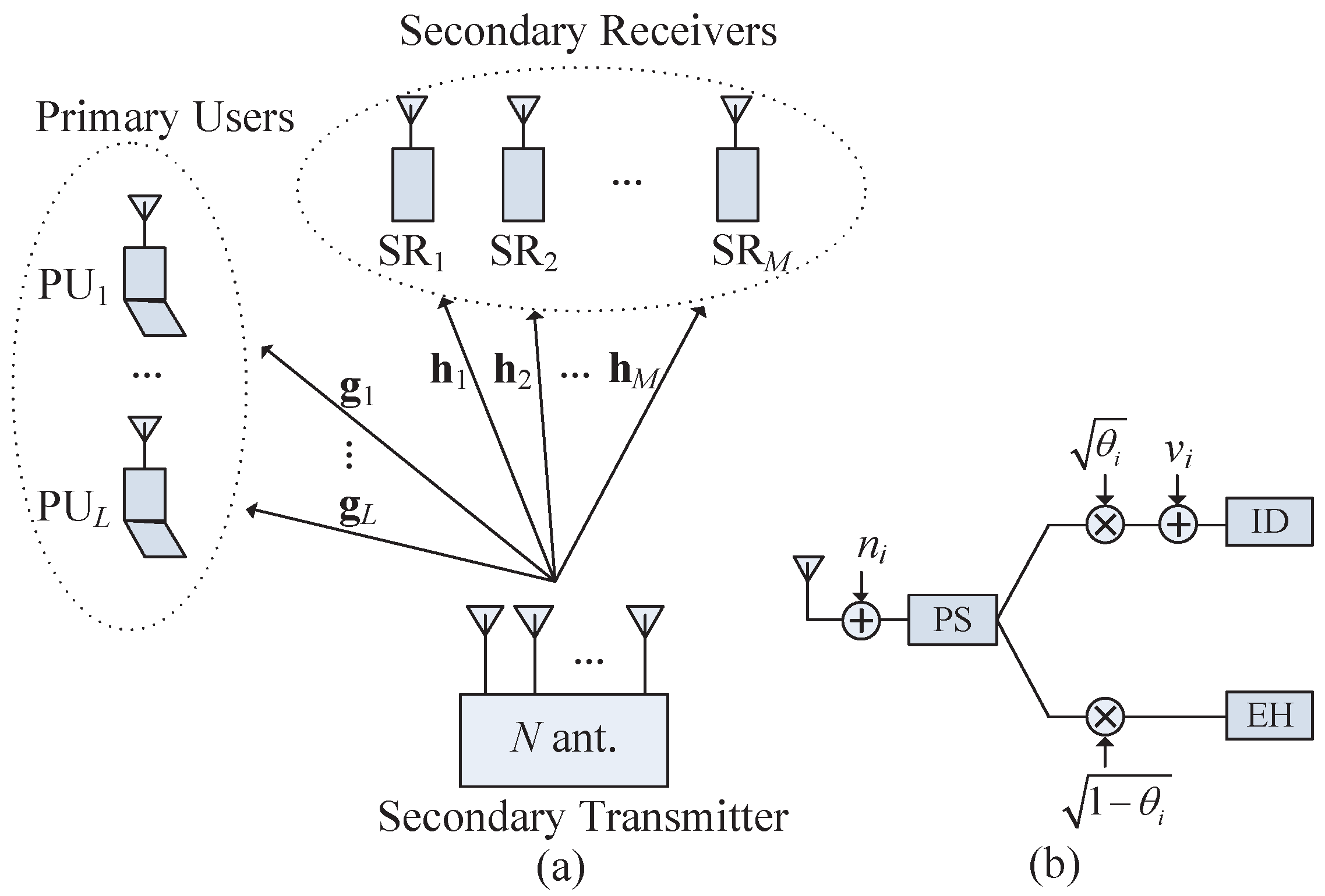
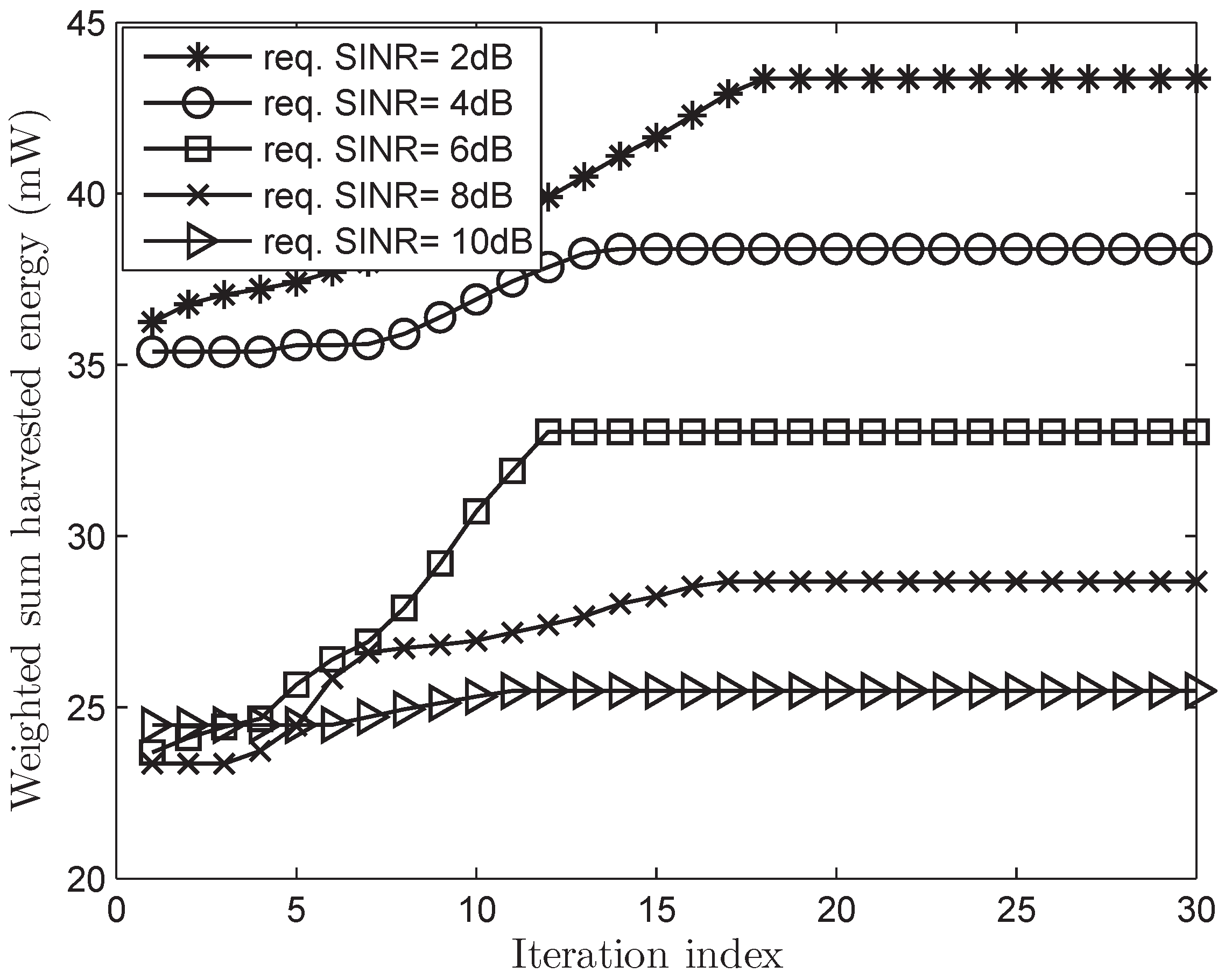

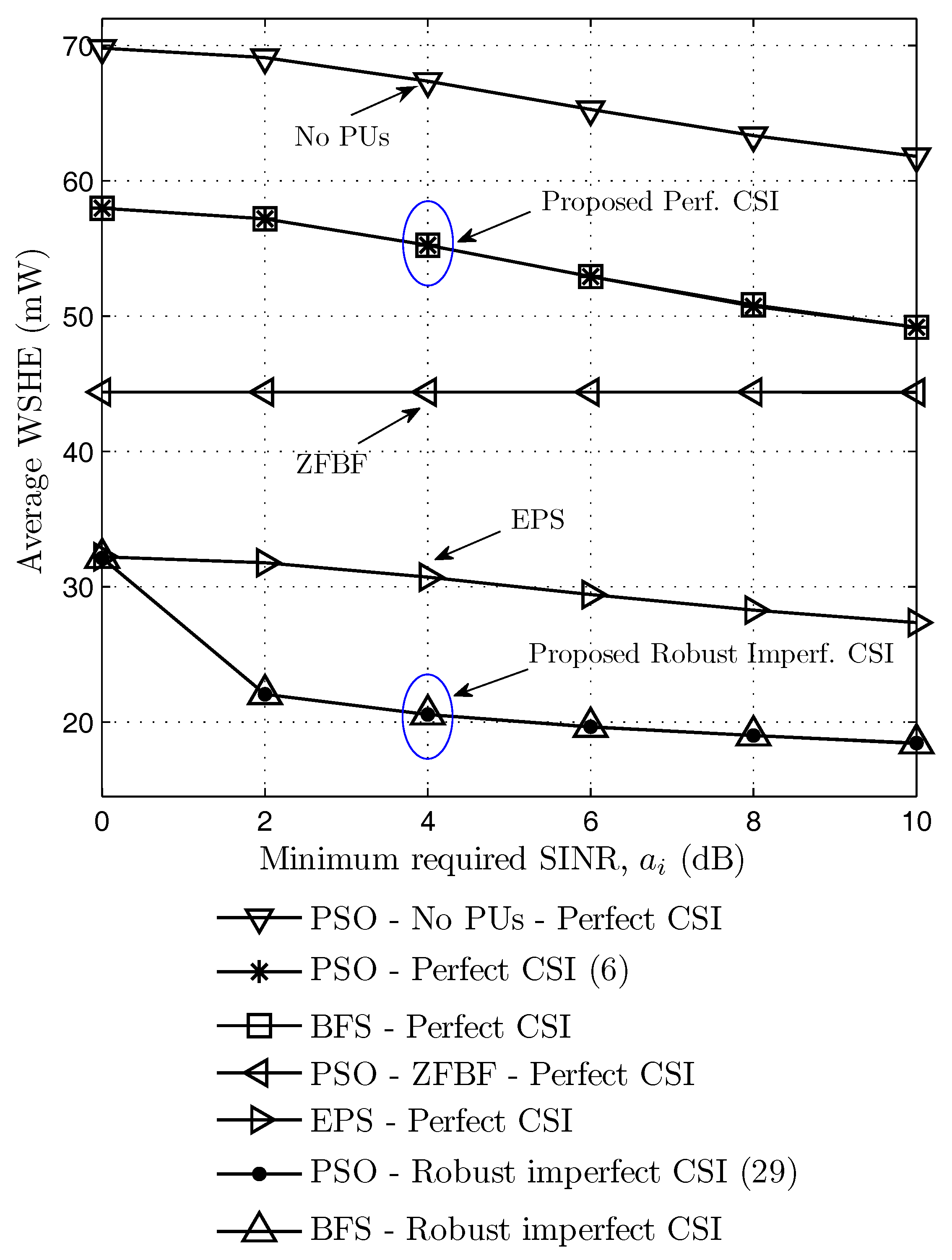
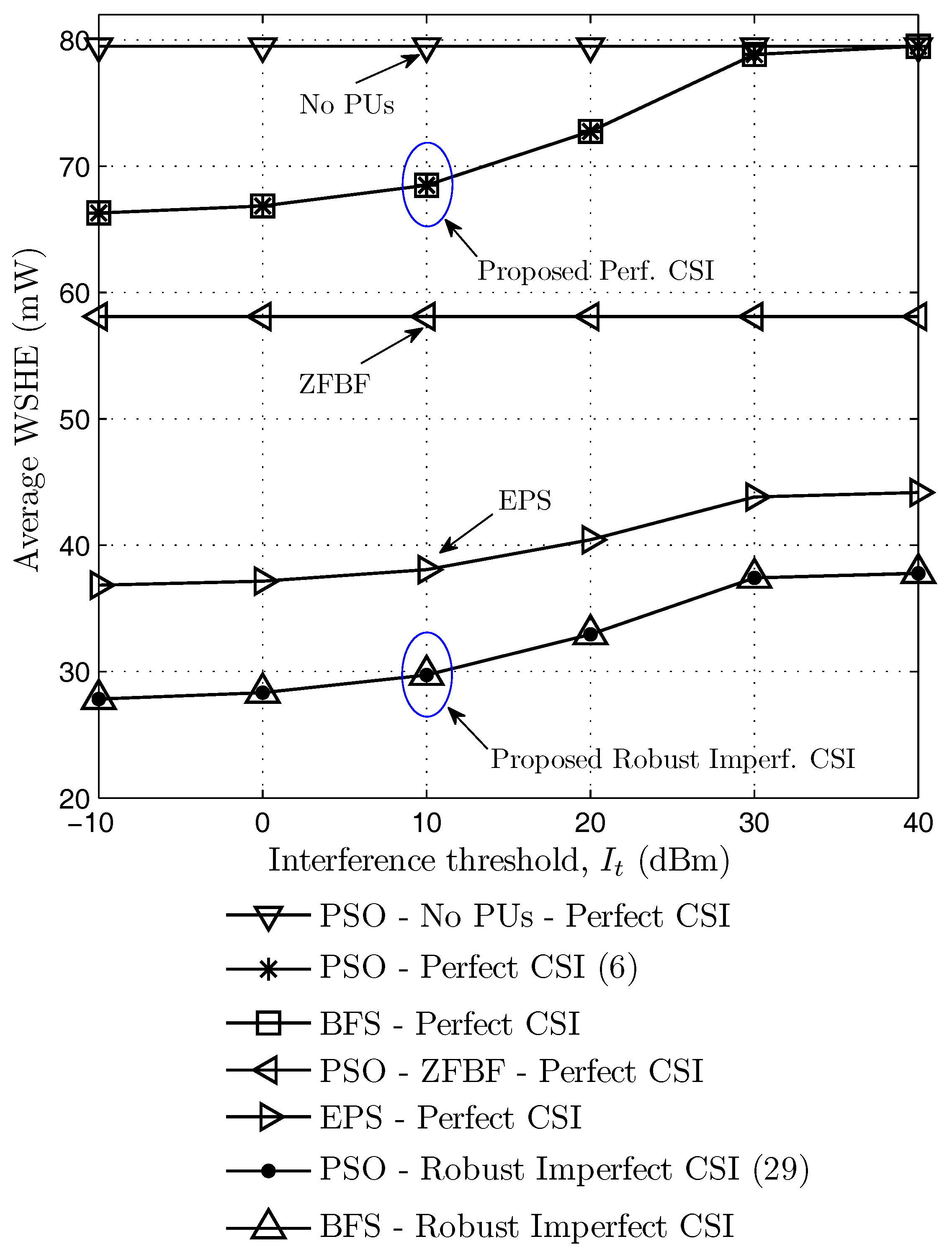
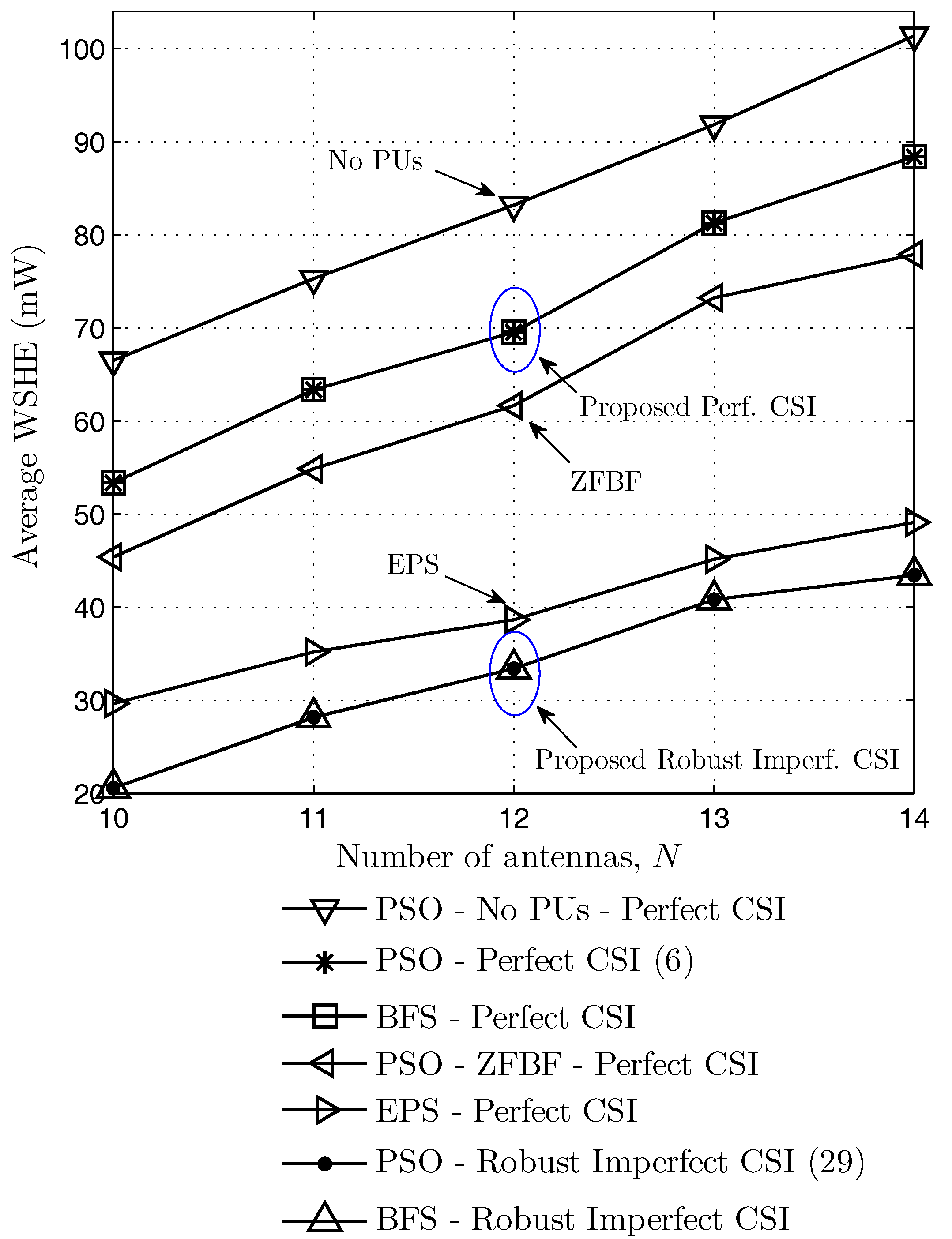
| Abbre. | Full Form | Meanings |
|---|---|---|
| CRNs | Cognitive radio networks [13] | The CRNs use licensed bands of primary networks for communication under overlay or underlay access modes. In this paper, the underlay access mode is applied where the interference from secondary transmitter to primary users is lower than the prescribed threshold. |
| SWIPT | Simultaneous wireless information and power transfer[1] | In this paper, the transmitter simultaneously sends both information and power to the receivers which are equipped with an information decoder and an energy harvester. |
| WSHE | Weighted sum harvested energy | WSHE is the sum of all harvested energy of secondary receivers where each value has one weight factor. |
| CSI | Channel state information | CSI is the complex value of the baseband channel between the transmitter and the receiver. |
| SDR | Semidefinite relaxation [20] | The fundamental idea of SDR is based on the properties as follows: and . Thus, we can change the variable from to by adding the constraints of and . Then, SDR technique removesthe constraint of to obtain the semidefinite programming problem solved by the numerical solver CVX [21]. This optimal solution needs to to be checked for satisfying the rank-1 constraint, or not. |
| PSO | Particle swarm optimization [22] | PSO is a heuristic evolutional search algorithm which is based on simulating a swarm of particles (birds, fish …) which share information of positions and fitness values with each other. For each iteration, PSO basically performs three steps, called velocity update, position update, and evaluation of the fitness function. Both deterministic and probabilistic rules are used to search overall design space. Each particle moves to a new position with likely improvement of fitness value. |
| ZFBF | Zero-forcing beamforming | In the ZFBF case, the transmitter designs the beamforming vector, bringing the intended message for one user and being orthogonal to the CSI of other users. Thus, ZFBF design does not cause interference to other users. |
| EPS | Equal power splitting | The receivers will share half the power of theincoming signal for information decoder, and half for the energy harvester. |
| 1: | input parameters: , , , , , , , |
| and variables , . | |
| 2: | initialization: |
| 2: | Assign the iteration index of PSO loop: . |
| 3: | The ’s values of elements, , are |
| assigned randomly in , then obtain by solving (8). | |
| 4: | Assign the global maximum value: . |
| 5: | Set the best position of particle: . |
| Set the velocity of particle: . | |
| 6: | repeat(PSO loop) |
| 7: | for do |
| 8: | Calculate particle’s new velocity: |
| , | |
| ⊙ denotes the Hadamard product, and the vectors , | |
| have independent uniformly distributed elements in . | |
| 9: | Restrict vector ’s each element in . |
| 10: | Calculate particle’s new position: . |
| 11: | Restrict each element of vector in . |
| 12: | Accessment: Compute and the optimal beamforming |
| variables , from the solution of problem (8)-SDR | |
| according to the PS ratios set, . | |
| 13: | Update the new best position of particle: |
| if then | |
| Assign: . | |
| end if | |
| 14: | Update particle’s new global best position: |
| if then | |
| Assign: , , . | |
| end if | |
| 15: | end for |
| 16: | Update iteration index: . |
| 17: | until (end PSO loop) |
| 18: | final results: the global best value is the optimal value of |
| WSHE problem (6) according to the optimal PS ratios , | |
| and the optimal beamforming vectors , . |
© 2017 by the authors. Licensee MDPI, Basel, Switzerland. This article is an open access article distributed under the terms and conditions of the Creative Commons Attribution (CC BY) license (http://creativecommons.org/licenses/by/4.0/).
Share and Cite
Tuan, P.V.; Koo, I. Robust Weighted Sum Harvested Energy Maximization for SWIPT Cognitive Radio Networks Based on Particle Swarm Optimization. Sensors 2017, 17, 2275. https://doi.org/10.3390/s17102275
Tuan PV, Koo I. Robust Weighted Sum Harvested Energy Maximization for SWIPT Cognitive Radio Networks Based on Particle Swarm Optimization. Sensors. 2017; 17(10):2275. https://doi.org/10.3390/s17102275
Chicago/Turabian StyleTuan, Pham Viet, and Insoo Koo. 2017. "Robust Weighted Sum Harvested Energy Maximization for SWIPT Cognitive Radio Networks Based on Particle Swarm Optimization" Sensors 17, no. 10: 2275. https://doi.org/10.3390/s17102275
APA StyleTuan, P. V., & Koo, I. (2017). Robust Weighted Sum Harvested Energy Maximization for SWIPT Cognitive Radio Networks Based on Particle Swarm Optimization. Sensors, 17(10), 2275. https://doi.org/10.3390/s17102275





